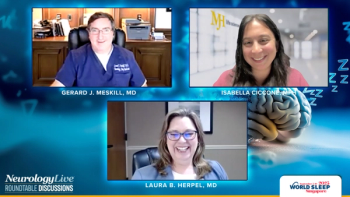In a recently published study evaluating frontal theta-transcranial alternating current stimulation (tACS), patients with multiple sclerosis (MS) treated with this approach demonstrated improvements in cognitive function after 1 session. The intervention was acceptable and tolerable, with information processing sleep enhanced and greater impacts not predicated on higher stimulation intensity.
Led by Wan Yu Hsu, PhD, an associate specialist in the department of neurology at the University of California, San Francisco, the study included 60 patients with MS with cognitive complaints who were enrolled into 3 groups (2 mA tACS, 1 mA tADCS, or sham) in a double-blind, randomized fashion. The study began with patients being assessed on their cognitive status through the Symbol Digit Modalities Test (SDMT), a traditional measure used.
Patients then underwent a 20-minute stimulation and completed a tablet-based cognitive program, AKL-T03 (vide infra). This cognitive tool was developed based on the principles of NeuroRacer, an innovative cognitive intervention designed to engage fontal neural networks. After the 20-minute stimulation, a second SDMT assessment was performed using a different version. Both participants, and study staff administering the tACS and SDMT, were blinded to stimulation group assignment.
READ MORE: ATA188 Fails to Meet Primary End Point In Phase 2 EMBOLD Study of Progressive MS
Coming into the study, 18 of the 60 participants had SDMT z scores of –1.5 or lower, with no significant differences between groups. Overall, after the intervention, the mean increase in SDMT was 2.89 (±1.31) for the 2mA group, 5.05 (±1.39) for the 1mA group, and 0.40 (±1.19) for controls. Post-hoc paired t-tests showed that the 1mA group had a significant increase in SDMT score after stimulation (t[17] = 3.63; P = .002; adjusted P with FDR correction = 0.006), the 2mA group showed a marginal improvement in SDMT score (t[18] = 2.20; P = .04; adjusted P = .06), while there was no significant change among controls (t[19] = 0.33; P = .74; adjusted P = .74).
Clinical Takeaways
- Efficacy of Frontal Theta-tACS in MS Patients: The study indicates that frontal theta-transcranial alternating current stimulation (tACS) may offer cognitive improvements in patients with multiple sclerosis (MS) after a single session, suggesting its potential as a viable intervention for addressing cognitive concerns in this population.
- Tolerability and Safety: The intervention was found to be acceptable and tolerable among MS patients, with no significant adverse effects reported. The mean scores for potential unpleasant tACS-induced sensations were low, supporting the notion that tACS is a well-tolerated approach in this patient population.
- Dose-Dependent Cognitive Effects: While both 1mA and 2mA groups demonstrated cognitive improvements, the 1mA group showed a significant increase in Symbol Digit Modalities Test (SDMT) score after stimulation, with a higher proportion achieving clinically meaningful improvements. Neurologists should consider the potential dose-dependent effects when exploring the application of frontal theta-tACS in MS patients for cognitive enhancement.
Additional findings revealed that 38% and 61% of those in the 2mA and 1mA groups, respectively, achieved clinically meaningful improvements in SDMT, demonstrated by increases of at least 4 points, vs 30% of those on sham. Pre- and post-tACS assessment using Cohen’s d showed a small effect size for the 2mA group (0.32) and a moderate effect size for the 1 mA group (0.51). Overall, the 1mA groups benefited from prefrontal cortex (PFC) theta-tACS but the 2mA group only showed a numerical improvement in SDMT after theta-tACS.
Between the 3 groups, there was no reported statistical differences in the perception of stimulation and all patients completed the study. On a scale of 0 to 10, the mean scores of each of the 10 potential unpleasant tACS-induced sensations were rated below 2.5 by patients, otherwise considered noticeable but not interfering with activities. None of the patients rated a score of 7 or higher for any of the 10 sensations, suggesting that tACS is a tolerable approach in this patient population.
"Mechanisms underlying tACS-induced SDMT improvement, such as changes in frontal theta activity, frontal network efficiency, and how the heterogeneity of brain lesions affects stimulation effect, should be investigated," the study authors wrote. "Further, the safety and tolerability of the intervention support its investigation in domains other than cognition, such as pain and fatigue. Finally, the acceptability and portability benefits suggest that it will be possible to adapt tACS to remote, in-home settings, which would substantially improve access to rehabilitative treatments to mitigate cognitive dysfunction in PwMS."
REFERENCE
1. Hsu WY, Zanto T, Park JE, Gazzaley A, Bove RM. Effects of transcranial alternating current stimulation on cognitive function in people with multiple sclerosis: a randomized controlled trial. Mult Scler & Relat Disord. 2023;80:105090. doi:10.1016/j.msard.2023.105090.





































